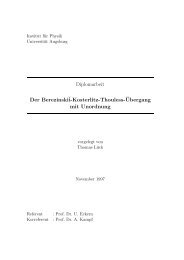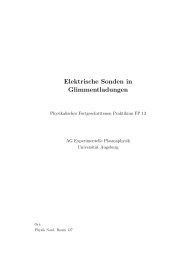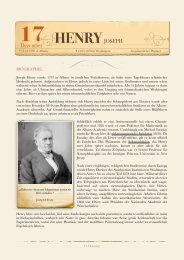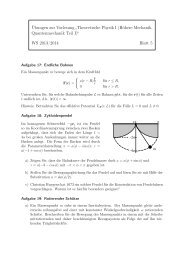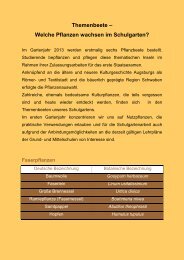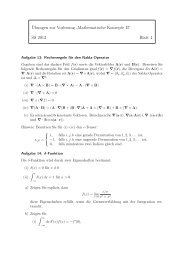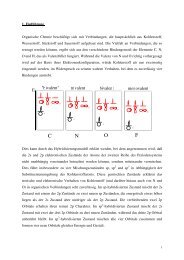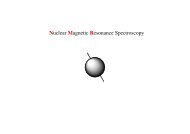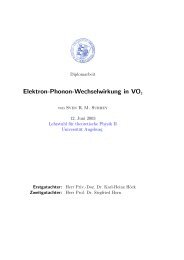Driven Quantum Systems - Institut für Physik
Driven Quantum Systems - Institut für Physik
Driven Quantum Systems - Institut für Physik
Create successful ePaper yourself
Turn your PDF publications into a flip-book with our unique Google optimized e-Paper software.
272 <strong>Driven</strong> <strong>Quantum</strong> <strong>Systems</strong><br />
The recursive matrix equation in (5.128) can be solved by using the ladder operators<br />
S m c m α = cm+1 α ,<br />
T −m c −m<br />
α<br />
= c −(m+1)<br />
α , (5.131)<br />
which are rising (lowering) the index m. The solutions of (5.131) can be given in terms<br />
of a matrix continued fraction, by iterating the recursive solution with m increasing,<br />
S m−1 = −[G(m, α)+H + S m ] −1 H −<br />
1<br />
=−<br />
H<br />
G(m, α) − H + 1<br />
− ,<br />
G(m +1,α)−H + ... H−<br />
T −(m−1) = −[G(−m, α)+H − T −m ] −1 H +<br />
1<br />
=−<br />
H<br />
G(−m, α) − H − 1<br />
+ . (5.132)<br />
G(−m − 1,α)−H − ... H+<br />
Setting m = 0 yields from (5.128) the linear system of equations<br />
G(0,α)c 0 α +H + S 0 c 0 α +H − T 0 c 0 α =0, (5.133)<br />
composed of both diagonal and — via S 0 , T 0 — also nondiagonal contributions. The<br />
quasienergies follow from the solubility condition,<br />
det[G(0,α)+H + S 0 +H − T 0 ]=0. (5.134)<br />
In practice, this system of equations is solved numerically, by evaluating S 0 and T 0<br />
truncated at some finite value m>0, i.e. one assumes S m =0,T −m = 0 for sufficiently<br />
large m, such that the result no longer changes significantly with increasing m. For an<br />
application of this MCF method to the problem of driven tunneling we refer the reader<br />
to the original literature [19].<br />
The above two sections discussed the case of periodic perturbations. A general timedependent<br />
interaction can be treated similarly — see Sect. 5.3 — by use of the multimode<br />
Floquet theory, or the general (t, t ′ )-formalism with the time interval T being<br />
chosen sufficiently large. Time-periodic boundary conditions can usually be assumed<br />
for finite (laser-)pulse interactions also, when the number of oscillations during the pulse<br />
lifetime is large. Alternatively, various direct methods for solving a time-dependent<br />
quantum problem exist. It should be stressed again, that an avoidance of the timeordering<br />
operator — via embedding (cf. Sect. 5.3) — results in a great simplification.<br />
Otherwise, the propagator must be split into short segments in which the Hamiltonian<br />
does not change significantly. Some keywords relating to these alternative direct timepropagation<br />
methods are the “split-operator technique” [20], and the “second-orderdifference<br />
schemes”. For recent surveys we refer the reader to the reviews in Ref. [21].



